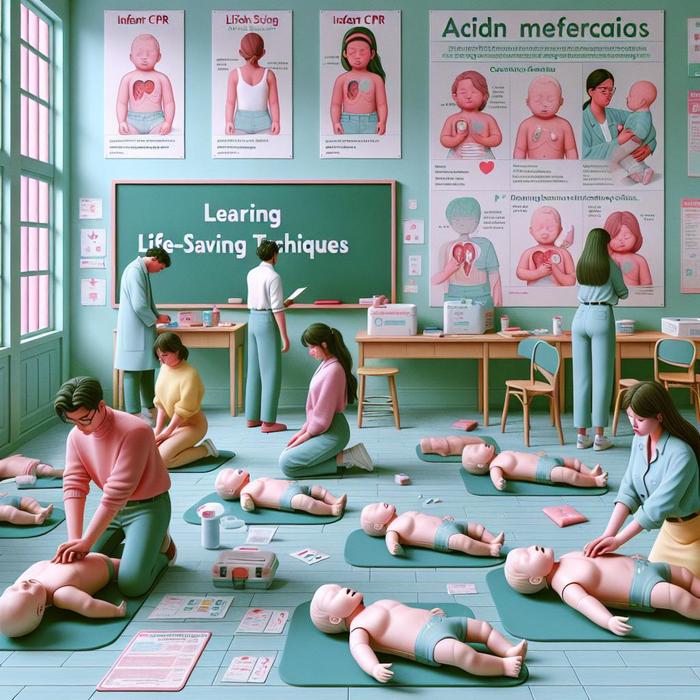Understanding the Importance of Infant CPR
As parents, we often find ourselves in situations where we have to make split-second decisions, especially when it comes to the safety of our children. One such critical skill we found invaluable was learning infant CPR. CPR, or Cardiopulmonary Resuscitation, is a lifesaving technique useful in numerous emergencies, including heart attack or near-drowning, where someone’s breathing or heartbeat has stopped. This blog post aims to share our experience and provide valuable infant CPR tips.
Why is Infant CPR Essential?
Babies are known for their curious and adventurous nature – two attributes that make them so lovable but also put them at risk of mishaps. From choking hazards to accidental falls – emergencies can occur at any time, anywhere. That’s why understanding the basics of baby first aid is as crucial as planning a nutritious meal or a peaceful sleep schedule.
According to the Mayo Clinic, knowing how to correctly perform CPR can mean the difference between life and death. We’ve rounded up some reasons why every parent should learn infant CPR:
- It’s a vital part of emergency preparedness
- Helps you respond effectively in a crisis situation
- Builds confidence in handling emergency situations
- Increases the survival rate of the victim
Our Journey to Learning Infant CPR
Just like many other parents, the thought of needing to perform CPR on our own child was frightening. But as the saying goes, “it’s better to be safe than sorry.” We enrolled in a CPR class specifically designed for infants, understanding the significance of learning lifesaving techniques.
The first thing we learned was the basic steps of CPR for infants – Check, Call, Care. We’ll discuss these steps more comprehensively in the next section.
Infant CPR: The Basic Steps
The key steps for performing Infant CPR, as outlined in the Lifesaving Society Guidelines, are as follows:
- Check: Assess the environment for any potential hazards. Next, examine the infant for consciousness by tapping or shaking their shoulder and shouting their name. If the infant does not respond, move to the next step.
- Call: If the infant is unresponsive, call 911 or ask someone else to do so. Provide them with all the necessary details.
- Care: Begin CPR by giving 30 chest compressions followed by two rescue breaths. Repeat until help arrives or the infant starts to breathe.
Every second count when performing CPR. Hence, these steps should be executed as quickly and efficiently as possible.
CPR Training for Parents
The easiest and most practical way to equip yourself with infant CPR skills is to sign up for a course. You can easily find these courses being offered by local healthcare institutions or professional organizations. We felt better prepared as parents after we enrolled in an Infant CPR training program.
Recognition of emergencies
Being confident enough to identify when CPR is needed is just as crucial as knowing the technique itself. Providing CPR is essential when there’s no breathing or choking is involved. However, one should understand that every choking incident does not require CPR. It’s necessary to make a quick decision with first aid for choking. If there are signs of severe choking, like the baby cannot cough, cry, or breathe, you would need to perform CPR.
Symptoms that Require Immediate Attention
Just like any other medical procedure or process, the basics of infant CPR shift and change with time and parental awareness. It’s vital to remain updated on these changes. Subtle body language signs like making unusual sounds, unable to talk, bluish skin color, and sluggish responses and movements could indicate the requirement of instant CPR.
These early warning signs are indicators of significant underlying conditions, especially if your child experiences difficulty while breathing or responding. If it comes to this, quick and appropriate use of CPR can be a lifesaver.
Guard Against Panic
While encountering situations that necessitate the use of CPR, it’s only natural for one to panic. However, it’s key to remember that panic could inevitably delay the essential act of initiating CPR. Try taking deep breaths and suppressing the panic so that you may handle the situation more effectively. Executing the Check, Call, Care instructions learnt in your CPR class will steer you in the right direction.
Yearly CPR Certification
One of the best means to refresh your skills and stay prepared is undergoing yearly CPR certification. Most courses provide convenient options that range from online classes to in-person sessions with practical, hands-on training sessions. We advise you to choose an option that allows for hands-on instruction. Even though online courses may be more convenient, being able to physically perform the process in a controlled setting has no equal.
Maintaining Regular Practice
Performing CPR is a high-pressure situation. Hence, it’s crucial to practice regularly. Doing so will keep the technique fresh in your memory and improve your preparedness to handle an emergency confidently. A good idea would be to acquire a mannequin approximating the body structure of an infant and follow the CPR Choking Instructions on a frequent basis.
At long last, the main takeaway from this article is hopefully the significance of parental preparedness in life-threatening emergencies. At the end of the day, remember this essential fact: doing something is better than doing nothing. Through infant CPR, you can potentially save your child’s life until the medical professionals arrive.
Final Thoughts
We sincerely hope that this post brings forth the essentiality of understanding and learning Infant CPR. Be sure to keep these points in mind and encourage other parents in your network to learn Infant CPR as well. The lives saved could be those of our loved ones.
Remember, every child’s life is precious, and it’s in our hands to protect it.
